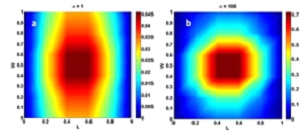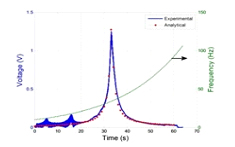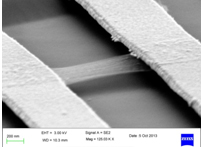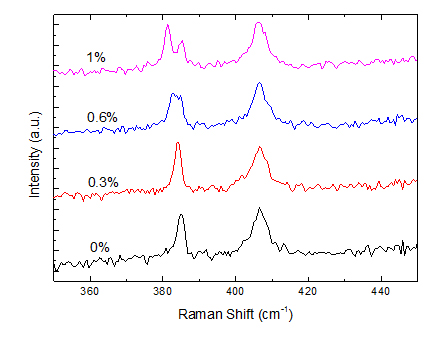 |
 |
| Fig. 1 FEM generated pressure distribution at a) low squeeze number (sigma = 1) and b) high squeeze number (sigma = 100) for a square plate with OCOC configuration. |
Fig. 2 Voltage output from a PVDF bimorph for 1 MO load resistance and 0.5 g input acceleration swept from 20 Hz to 100 Hz. |
Energy Dissipation in Oscillations of Micro and Nano Scale Structures: Most of the devices and structures we design and develop exploit the dynamic response of some structural element for their essential operation. In studying these devices, one particular aspect of their response that has fascinated us the most is the energy dissipation at the micro and nano scales. Any dissipation of energy from the oscillating structure directly impacts its quality factor, Q. With so much interest in developing high-Q MEMS and NEMS devices, it becomes imperative to have a good understanding of energy transport from the oscillating structures. It turns out that in most cases, the fluid-structure interaction with the surrounding fluid (mostly air) is responsible for maximum energy dissipation. Prof. Rudra Pratap‘s group is investigating squeeze film damping and acoustic radiation losses, and their effect on the Q of MEMS devices. Squeeze film damping refers to energy dissipation in fluid flow caused by “squeezing” of a very thin film of air or some other gas trapped between an oscillating mechanical structure and a fixed substrate. We have been interested in understanding squeeze film flow and the associated energy dissipation in all kinds of flow conditions—from continuum to molecular flow. We are also working on understanding acoustic radiation from these tiny structures and the associated energy losses particularly relevant to 2-D structures.
Noise sources in NEMS: The sensitivity of the sensors critically depends on the stability of the resonant frequency of these devices. As the dimensions of the devices shrink to nanometer levels, noise processes which can easily be ignored at micro-scale become important. Prof. Akshay Naik’s group investigates the frequency stability of these resonant devices due to various noise sources.

Fig. 3 Suspended monolayer graphene for frequency noise investigations
Strain Engineering: The band gap of layered semiconductor including MoS2 can be tuned by straining. These materials hold great promise for making hybrid structures which can be manipulated to obtain desired characteristics. Prof. Naik’s group is working towards fabricating suspended MoS2 structures whose optical and electrical properties can be tuned by applying electrically controlled strain.

Figure 4: Effect of strain on the Raman spectra of MoS2
|
Associate Professor |
Professor |
Professor |
Assistant Professor |